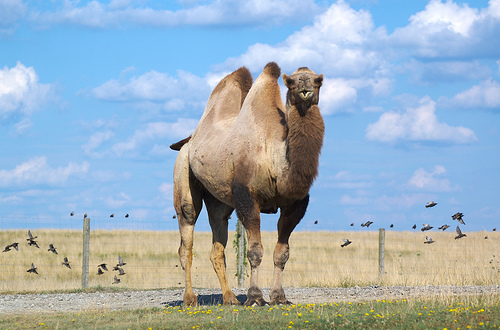Bactrian camels are fully equipped for their harsh habitat.
- Bactrian camels are two-humped camels that are native to central parts of Asia and they have thick fur that is coloured brown and tan.
- The scientific name of a domesticated Bactrian camel is Camelus bactrianus, from the family Camelidae, and the animal is said to differ from the wild Bactrian camel, and as such, the wild camels are generally considered a different species that have the scientific name Camelus ferus.
- Bactrian camels generally grow to heights of 1.7 to 2.3 metres (5.5 to 7.5 feet) and weigh between 300 to 1000 kilograms.
- Bactrian camels primarily live in desert habitats, that feature a wide variety of conditions and temperatures, as well as limited water and food; while the wild camel species have the ability to drink salty water.
- The large feet of Bactrian camels assist with mobility on sand, while their lengthy eyelashes and closable noses filter out sand from sandstorms.
Bactrian Camels
Image courtesy of Jeff Kubina/Flickr
- Bactrian camels have two humps that contain fat, and when food and water resources are low, the fat is used to nourish the camel, and as a result the humps become slumped and smaller.
- Throughout ancient times, and still today, Bactrian camels have been used as pack animals, capable of carrying loads up to 250 kilograms (550 pounds) in weight, and they have also been used for transporting humans.
- The diet of Bactrian camels consists primarily of a wide variety of vegetation, including grass, shrubs and seeds, and they regurgitate their food so that it can be rechewed (known as ‘chew their cud’).
- Despite having very few predators, that include humans and wolves, wild Bactrian camels have been listed as critically endangered; and it is thought that this wild species only number up to 800 or 900 individuals, with the figure reducing.
- Generally, one calf is born to female Bactrian camels every two years, and they have an average lifespan of 35 to 50 years.
Bibliography:
Bactrian Camel, 2013, A-Z Animals, http://a-z-animals.com/animals/bactrian-camel/
Bactrian Camel, 2015, National Geographic, http://animals.nationalgeographic.com.au/animals/mammals/bactrian-camel/
Bactrian Camel, 2015, Wikipedia, http://en.wikipedia.org/wiki/Bactrian_camel







